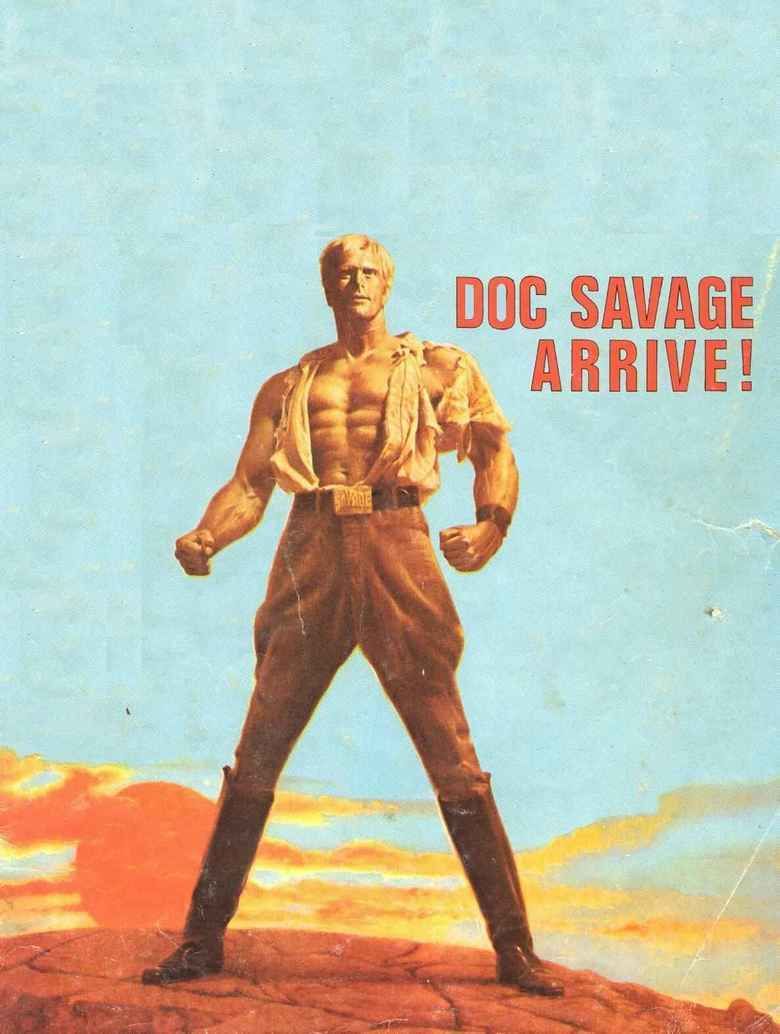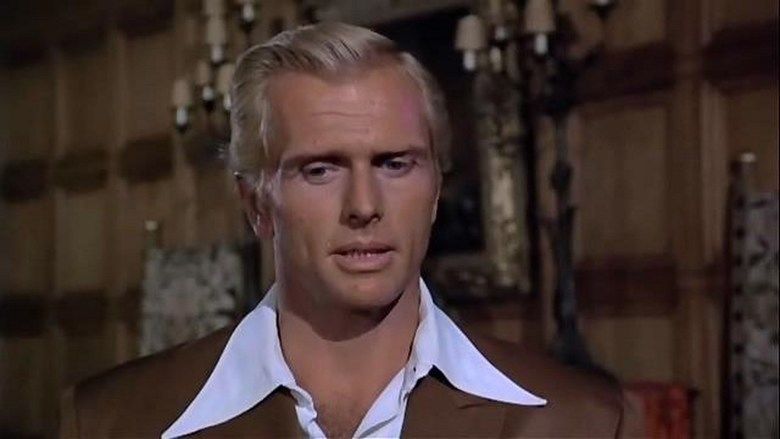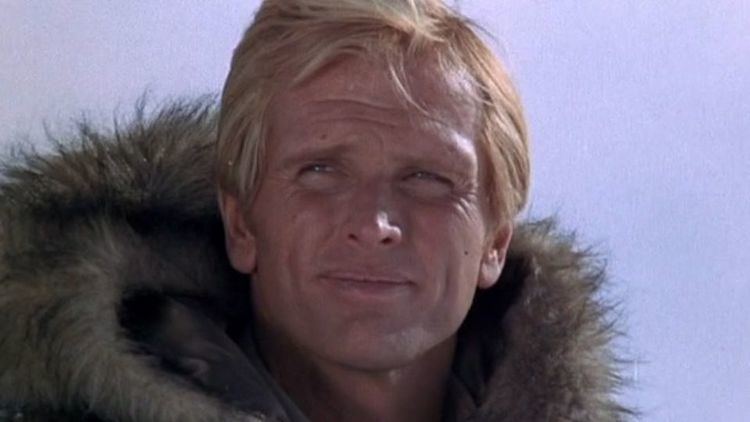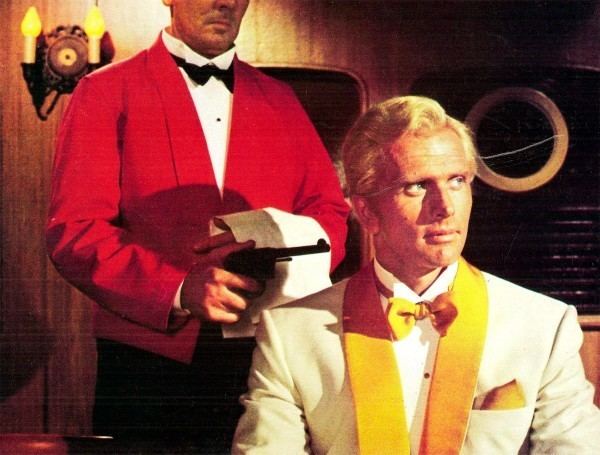Doc Savage: The Man of Bronze
5.8 /10 1 Votes
60% Rotten Tomatoes Genre Action, Adventure, Comedy Language English | 5.5/10 IMDb Duration Country United States | |||||||||||||||||||||||||||||||||
 | ||||||||||||||||||||||||||||||||||
Release date June 1975 (1975-06) Cast (Clark 'Doc' Savage Jr.), (Maj. Thomas J. 'Long Tom' Roberts), (Col. John 'Renny' Renwick), Michael Miller (Lt. Col. Andrew Blodgett 'Monk' Mayfair), (William Harper 'Johnny' Littlejohn), (Brig. Gen. Theodore Marley 'Ham' Brooks)Similar movies This Island Earth , The Fiend of Dope Island , Shock Waves , Amazon Women on the Moon , Blacula , Beyond the Forest | ||||||||||||||||||||||||||||||||||
Doc savage the man of bronze 1975 official trailer ron ely paul gleason movie hd
The two-fisted adventurer assembles his team of specialists to locate the man who murdered his father.
Contents
- Doc savage the man of bronze 1975 official trailer ron ely paul gleason movie hd
- Plot
- Doc savage the man of bronze original theatrical trailer
- Cast
- Goodson Todman aborted 1966 Film
- George Pals 1975 theatrical film
- Thematic issues faithfulness to the source material
- Reception and reaction
- Sequel and future productions
- Other productions
- Awards
- Home video
- References

Doc Savage: The Man of Bronze is a 1975 American action film starring Ron Ely as pulp hero Doc Savage. This was the last film completed by pioneering science fiction producer George Pal. It was directed by Michael Anderson, who had previously directed another big-budget adventure film, Around the World in 80 Days.

In the Fabulous Thirties, Doc Savage and his five Amazing Adventurers are sucked into the mystery of Doc's father disappearing in the wilds of South America. The maniacal Captain Seas tries to thwart them at every turn as they travel to the country of Hidalgo to investigate Doc's father's death and uncover a vast horde of Incan gold.
Plot
Doc Savage (Ron Ely) returns to New York City following a visit to his Arctic hideaway, the Fortess of Solitude. He learns that his father has died under mysterious circumstances while exploring the remote interior of the Central American Republic of Hidalgo. While examining his fathers personal papers, Doc finds himself the target of an assassination attempt. Doc Savage chases and corners the sniper on the nearby Eastern Cranmoor Building, but the would-be assassin loses his footing and falls to his death. Examining the body, Doc discovers that his assailant is a Native American with peculiar markings; his fingertips are red, as if dipped in blood, while his chest bears an elaborate tattoo of the ancient Mayan god Kukulcan. Returning to his penthouse headquarters, Doc finds that intruders have destroyed his fathers personal papers. Vowing to solve his fathers murder, Doc Savage flies to Hidalgo with "The Fabulous Five", his brain trust, at his side.

Waiting for Doc Savages arrival is the international criminal and smuggler Captain Seas (Paul Wexler) who repeatedly attempts to kill Doc and his friends, culminating in a wild melee onboard his yacht, the Seven Seas. Meanwhile, Docs investigation uncovers that, years ago, Professor Savage received a vast land grant in the unexplored interior of Hidalgo from the Quetzamal, a Mayan tribe that disappeared 500 years ago. However, Don Rubio Gorro (Bob Corso) of the local government informs Doc that all records to the land transaction are missing. Doc receives unexpected help from Gorros assistant, Mona Flores (Pamela Hensley), who saw the original papers and offers to lead Doc and his friends to the land claim.

Following clues left by his father, Doc and his friends locate the hidden entrance into a valley where the lost Quetzamal tribe lives. Doc separates from the group and finds a pool of molten gold. Doc also learns that Captain Seas is using the Quetzamal natives as slave labor to extract the gold for himself. Meanwhile, Seas men capture Mona and The Fabulous Five, and Seas unleashes the Green Death, the same airborne plague that killed Docs father and keeps the Quetzamal tribe under his control. Doc overpowers the Captain after a protracted clash of different fighting styles and forces Seas to release his friends, whom Doc then treats with a special antidote. Seeing their leader captured, the Captains men try to escape with the gold, but exploding dynamite causes the pool of gold to erupt, covering the henchmen, including Don Rubio Gorro, in molten metal. Freed from Captain Seas, Chief Chaac (Victor Millan) offers the gold and land grant to Doc, who replies, "I promise to continue my fathers work ... his ideals. With this limitless wealth at my disposal, I shall be able to devote my life to the cause of justice."
Doc Savage returns to the United States and performs acupuncture brain surgery on Captain Seas to cure him of his criminal behavior. Later, during Christmas season, Doc Savage encounters the former supervillain, who is now a bandleader for the Salvation Army, flanked by his former paramours Adriana and Karen. Arriving back at his penthouse headquarters from shopping, Doc hears an urgent message about a new threat that could cost millions of lives. Doc Savage leaps into action and speeds to his next adventure.
Doc savage the man of bronze original theatrical trailer
Cast
Other noteworthy casting included:
Goodson-Todman aborted 1966 Film
As co-creator of Doc Savage, author Lester Dent retained the radio, film, and television rights to the character as part of his contract with Street and Smith Publications, publishers of the Doc Savage pulp magazine. Although Dent succeeded in launching a short-lived radio program, he was never able to interest Hollywood in a Doc Savage film. Upon Dents death in 1959, his widow, Norma Dent, acquired the radio, film, and television rights to Doc Savage.
The production team of Mark Goodson and Bill Todman announced the intention to produce a Doc Savage film to cash in on the popularity of the re-issued pulp novels by Bantam Books and the James Bond craze sweeping the movies.
The film would be based on the July 1934 pulp novel The Thousand-Headed Man, with Chuck Connors as Doc, for a 1966 release.
Unfortunately, the producers and Conde Nast Publications, the new copyright owner to Doc Savage brand, failed to secure the film rights from the estate of Lester Dent. By the time the legal issues had been resolved, the production team and cast had moved on to do the offbeat western Ride Beyond Vengeance.
Only the one-shot comic book movie tie-in (pictured) published by Gold Key, with cover artwork by James Bama, remains to mark this aborted film undertaking.
George Pals 1975 theatrical film
Producer George Pal secured the film and television rights from Norma Dent with the intention of launching a film franchise like the James Bond movies. Ever the businessman, Pal envisioned marketing and production savings from such a series, with an eventual sell to television to recoup any back-end costs, followed by an eventual television series, just as Sy Weintraub had done with Tarzan and Irwin Allen with Voyage to the Bottom of the Sea. However, to make a franchise work, the first movie had to be successful. Pal originally contacted Steve Reeves for the role of Doc but when filming was about to begin a Hollywood writers strike put the film on hold with Reeves and the original director replaced.
George Pal and Joe Morhaim wrote the screenplay based on The Man of Bronze, the first Doc Savage adventure, with additional story elements from other Doc Savage adventures, such as the November 1938 novel The Green Death and the January 1935 novel The Mystic Mullah.
The villainous Captain Seas, played by Paul Wexler, was based on the flamboyant and brutal Captain Flamingo from the February 1936 pulp novel Mystery of the Sea. This should not be confused with the Canadian television character Captain Flamingo. English director Michael Anderson would helm the first Doc Savage movie. His specialty was action-adventure films, such as Dam Busters, Battle Hell, The Wreck of the Mary Deare, and Operation Crossbow. His most noteworthy effort had been Around the World in Eighty Days, the Best Picture of 1956.
Although there were reports that Pal planned to do location filming in Central America, principal photography was confined to southern California. Scenes involving the fictitious Eastern Cranmoor Building in New York City were filmed underneath the clock tower of the art deco Eastern Columbia Building in downtown Los Angeles.
Ron Elys involvement extended beyond starring in the lead role. He reportedly directed several second unit sequences, including staging the fight onboard Captain Seas yacht Seven Seas, which featured stuntman Dick Durock who later starred in the Swamp Thing films and television series. Also, the portrait of Professor Clark Savage, Sr., in Docs penthouse headquarters actually shows actor Ron Ely wearing a vintage safari outfit and pith helmet, with a handlebar moustache.
Pamela Hensley made her film debut in this motion picture.
Darrell Zwerling and Federico Roberto appeared in another 1930s nostalgia film, the 1974 film noir retro classic Chinatown, with Zwerling playing Hollis Mulwray, the murdered water commissioner.
Paul Frees, who provided the uncredited voice-over narration for the opening title sequence, also made a rare on-screen appearance in the 1953 version of War of the Worlds as well as performing the narration and other voice work for the 1960 fantasy film Atlantis, the Lost Continent, both produced by George Pal.
The film features a rare Cord Model 810 convertible coupe (license number NY 36 486-539) and a vintage Lockheed L-12A Electra aircraft, serial number 1203, original tail number NC16077, first registered to Continental Oil in 1936. The plane became famous as G-AFTL when flown by Sidney Cotton, who used it for spying on the Germans during World War Two. It was later owned by airshow pilot Art Scholl and flown in the 1976 two-part TV miniseries Amelia Earhart, the 1976 CBS-TV adventure series Spencers Pilots and the 1977 TV movie The Amazing Howard Hughes in addition to Doc Savage: The Man of Bronze. It is currently registered with the tail number N12EJ to the Runyan family of Vancouver, WA.
Thematic issues & faithfulness to the source material
Doc Savage: The Man of Bronze was visually faithful to the novels and characters, which included such elements as:
Other aspects of the Doc Savage mythos were modified for the movie. For example, The film takes place in 1936, but the original pulp novel was published in March 1933. Most Doc Savage chronologies place the events in The Man of Bronze in early 1931 prior to the official opening of the Empire State Building, the implicit location of Docs 86th floor penthouse headquarters. The film does not mention that Docs father, Professor Clark Savage, Sr., was instrumental in raising his son from the cradle to become the supreme adventurer under the tutelage of a blue-ribbon group of distinguished scientists. The Seven Seas is actually the name of Doc Savages private motor yacht in the pulp novels written by Lester Dent. Finally, Long Tom (Paul Gleason) mentions that Monk, Ham, Renny, Johnny, and he first met Doc Savage while fighting in the trenches during World War I and vowed to work together against evil-doers after the war. The 1991 novel Escape From Loki by Philip Jose Farmer retroactively tells the story of how Doc first met The Fabulous Five in a high-security German POW camp in 1918. Finally, the opening titles used the same typography (pictured) used in the Bantam Books reprints of the Doc Savage pulp novels.
Debate continues as to who was responsible for the camp content of Doc Savage: The Man of Bronze, the studio or George Pal and his production team. Among the many examples of over-the-top camp include Don Rubio Gorro (Bob Corso) rocking himself to sleep in an adult-sized baby crib, with Beautiful Dreamer as its musical cue, the animated twinkle in the eye of Doc Savage (Ron Ely) at the beginning of the film and later when Doc tells Mona (Pamela Hensley) that she was a brick. "La Cucaracha", played by a flute was used in an up-tempo musical cue, during the attempted escape of Captain Seas henchmen from the Valley of the Vanished, and finally, an applause soundtrack was added following Docs recitation of his personal code.
The film is also remembered for its theme song arranged by Frank De Vol, based on John Philip Sousas The Thunderer. Sousa’s music was intended to evoke a patriotic theme for Doc Savage: The Man of Bronze and attempted to emulate the success that director George Roy Hill and composer Marvin Hamlisch had achieved when they used the ragtime music of Scott Joplin for the 1975 caper film The Sting. Both Sousa and Joplin were turn-of-the-century composers, and their music was not contemporaneous to the period that these 1930s nostalgia films were set. The credit acknowledging Sousas score has the letters "USA" in his last name highlighted in red, white, and blue.
Reception and reaction
Producer George Pal reported to Edward Felipe in the magazine Castle of Frankenstein that "We made it too good." However, Doc Savage: The Man of Bronze proved to be inferior in every production category – set design, art direction, costuming, hair style – to Chinatown, The Sting, Murder on the Orient Express, and other 1930s nostalgia films released during this period. Even Pals trademark visual effects and matte paintings were mediocre, with the depiction of the Green Death as animated serpentine vapors being particularly unconvincing (pictured).
The decision by Warner Brothers to shift the release date from the Spring of 1974 to Easter 1975 denoted a lack of confidence in the production and its box office potential. However, a 16-page press kit was prepared, and Ron Ely participated in a press junket that included an appearance in the WSB-TV annual Fourth of July parade in Atlanta, Georgia.
Reviews were scathing, with Daily Variety noting: "Execrable acting, dopey action sequences, and clumsy attempts at camp humor mark George Pals Doc Savage as the kind of kiddie film that gives the G rating a bad name."
The movie proved to be a disappointment for both die-hard Doc Savage fans and the general public. The film did not do well at the box office, and it soon disappeared in a summer dominated by the blockbuster box office of Jaws.
Sequel and future productions
A sequel, Doc Savage: The Arch Enemy of Evil, was announced at the conclusion of The Man of Bronze. Based on a screenplay by Joe Morhaim, and according to contemporary news accounts, it had been filmed in the Lake Tahoe area simultaneously with the principal photography for the first Doc Savage. However, people associated with the production of the film have said only some publicity shots were taken at Tahoe. No filming was done.
According to the screenplay that was posted on the Internet, the sequel was based very loosely on the October 1934 pulp novel Death in Silver, which also featured a deformed, German-speaking supervillain and a man-eating octopus found in the September 1937 pulp novel The Feathered Octopus. However, due to the poor reception of the first film, Doc Savage: The Arch Enemy of Evil was scrapped.
Other productions
Another script was written by fantasy author Philip Jose Farmer, and included a meeting between Doc and a retired Sherlock Holmes in 1936, but it was never filmed.
Then, following the box-office success of the 1999 remake of The Mummy, Castle Rock Entertainment announced plans to produce a new Doc Savage movie with Warner Brothers and Universal Studios. Film-makers Frank Darabont and Chuck Russell would supervise the production, based on a screenplay by Brett Hill and David Johnson, with Arnold Schwarzenegger attached to play Doc. However, with Schwarzenegger serving as governor of California, and both Darabont and Russell involved in other projects, this proposed production came to nothing and has since been shelved.
In late 2006, director-producer Sam Raimi was rumoured to be making a film involving several Street and Smith pulp heroes, including The Shadow, The Avenger, and Doc Savage. A screenplay was supposedly written by Siavash Farahani but since then, no other news has surfaced with regards to this script.
In 2010, it was announced that Shane Black is set to direct and write a new film adaptation, set in the pulps native time of the 1930s, for Original Film and Sony Pictures.
Awards
Doc Savage: The Man of Bronze received the 1974–1975 Golden Scroll for Best Fantasy Film from the Academy of Science Fiction, Fantasy & Horror Films.
Home video
Doc Savage: The Man of Bronze was initially released by Warner Home Video in a clamshell box, at the time denoting a family film, with cover art designed to capitalize on the success of Raiders of the Lost Ark. The film was also released onto Laserdisc and there is a DVD available in Germany (with German and English language).
In March 2009, the movie was made available within the United States as part of Warner Brotherss "Warner Archive" manufacture-on-demand DVD service, at a price of $19.95 for a DVD containing the movie presented in its original aspect ratio, and its trailer in 4:3.
References
Doc Savage: The Man of Bronze WikipediaDoc Savage (film) IMDbDoc Savage (film) Rotten TomatoesDoc Savage: The Man of Bronze themoviedb.org
